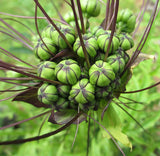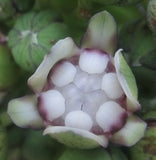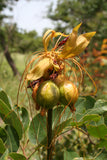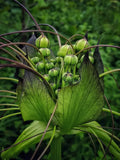Product Description: Tacca leontopetaloides Seeds — Echoes of the Bat Flower & Islands of Story
Grow more than just a plant—grow a living legend. Tacca leontopetaloides emerges from a powerful tuber, springing into starbursts of greenish-purple umbrella blooms crowned with dramatic whisker-like bracts that whisper of tangled forest floors and tropical myth.
Bloom & Foliage Features
-
Bloom Color & Form: The inflorescences are tall umbrellas dotted with 20 or more greenish-purple flowers, framed by long, trailing, filament-like bracts that resemble a mystic bat's wings in an enchanted forest. The hidden blooms sit beneath these striking bracts, offering a theatrical floral debut.
-
Foliage & Structure: Leaves erupt from an underground tuber on grooved, celery-like petioles and spread in dramatic lobes, 30–120 cm across. The plant dies back seasonally to its tuber, re-emerging with bold elegance.
Hardiness & Cultivation
-
USDA Hardiness Zones: As a tropical understory plant, it excels in Zones 9–11, best in partial shade with warm, humid conditions—perfect for terrariums or tropical-themed gardens.
-
Growth Habit: A striking perennial, Tacca melts back during dormancy and regenerates from its tough tuber. Flowers rise up in mysterious splendor when conditions align.
Wildlife Interactions
-
Pollinator Enigma: While not documented as a larval host, the exotic bloom structure is believed to attract specialized pollinators—possibly flies or nocturnal insects—drawn to its enigmatic shape, scent, and forest-deep camouflage. The "bat-plant" form hints at sophisticated ecological storytelling.
Cultural Significance & Traditional Use
-
Ancient Island Staple: Known as Polynesian Arrowroot, this plant was once a crucial root crop across the Pacific—a provisioning food on remote atolls where resilience was survival.
-
Staple to Ritual: Emerging from Lapita-era sites dating back millennia, its presence speaks to human migration, survival, and reverence.
-
Edible Treasure: The starch extracted from its tubers sustained islanders through cycles of abundance and famine. Though raw tubers are bitter and must be washed to eliminate toxins, the resulting starch was used in puddings, thawing food traditions into present-day kitchens.
-
Creative Material: Beyond food, its fibers were used for weaving mats and its starch for strengthening cloth—this plant was woven into the fabric of island life.
Why These Seeds Belong in Your Garden
-
Nocturnal Glory: A floral scene that unfolds like forest theater—graceful, rare, and unforgettable.
-
Botanical Heritage: Cultivate a plant that shares ancient tales of migration, survival, and island ingenuity.
-
Sensory Mystery: Not just a visual marvel—its scent, form, and structure intrigue pollinators in secretive ways.
-
Cultural Vessel: From food to fiber, every part of this plant carried meaning—now, it carries story.
Plant Tacca leontopetaloides seeds and watch not just a plant but a legend bloom—bridging continents, cultures, and centuries from your own garden.










